FERRARI 550 MARNANELLO SERVICED GIALLO YELLOW DAYTONA SEATS 275 YELLOW HRE
1997 Ferrari 550 MARANELLO
Ferrari 550 1997 technical specifications | |
|---|---|
| Condition: | Used |
| Item location: | Beverly Hills, California, United States |
| Make: | Ferrari |
| Model: | 550 |
| SubModel: | MARANELLO |
| Type: | Coupe |
| Trim: | COUPE |
| Year: | 1997 |
| Mileage: | 19,500 |
| VIN: | ZFFZR49A2V0109567 |
| Color: | YELLOW |
| Engine size: | V12 |
| Number of cylinders: | 12 |
| Power options: | Air Conditioning, Power Locks, Power Windows, Power Seats |
| Transmission: | Manual |
| Drive type: | REAR DRIVE |
| Interior color: | BLACK |
| Safety options: | Anti-Lock Brakes, Driver Airbag, Passenger Airbag |
| Options: | Cassette Player, Leather Seats, CD Player |
| Vehicle Title: | Clear |
| You are interested? | Contact the seller! |
Description |
|---|
You are looking at an investment grade Ferrari 550 Maranello and one of the very best cars ever to come out of the Ferrari factory.
This is truly a spectacular condition Ferrari 550 Maranello. I have seen two 550s with 6,000 miles on them and they did not look as good as this car.
This Maranello features the rare and strikingly handsome Giallo Modena color paint, n outstanding glove soft leather interior and an engine clean enough to eat from.
Appearing as nearly new are the black leather Daytona leather seats and the mint condition diamond leather rear shelf.
The original official color of Ferrari was in fact Giallo (yellow) as this is the official color of Modena, taly where Enzo Ferrari was born and where he located his factory. Red was the color of Italy (as green was England, lue for France, ilver for Germany, tc.) but the actual color of Ferrari was yellow, hich is why this color is called Modena Yellow (and why the Ferrari badge features a yellow background behind the prancing horse).
Whereas red maybe too flashy for some or simply far too common, his yellow has the same visual power as the red, f not more, hile being far more rare and less ostentatious. While there are many red, lack, lue, ilver and grey 550s yellow Maranellos are particularly rare.
This Ferrari looks more like a one-year old car rather than a nearly 20 year-old classic Ferrari, uch is its exceptional condition.
The dash is as new and with none of the typical drying or shrinkage issues. The leather seats, eaturing their “Daytona” pattern, re as new and without wear. There are no sticky parts.
The Books and Manuals and their leather pouch and the Leather toolkit are included as shown in the photograph.
The major service was recently performed, ncluding new timing belts, ensioner bearings, rive belts, ilters, ils, luids, askets and seals, nbsp;spark plugs, ollen filter, tc.
Also included are a set of premium HRE wheels with Michelin tires with the Buy It Now (265 mm/ 19” front and 325 mm / 20” rear) that cost nearly $9,000. (I will try and get a photo of these wheels on the car and post the pic in the next couple of days.) The wheels look absolutely stunning on the 550.
The OEM wheels are as new and will feature brand spanking new freshly mounted Bridgestone Potenza tires (Bridgestone Potenzas were an OEM tire fitment for the 550 from Ferrari when new) with their stickers still on them on the buy it now.
The 550 Maranello is one of the hottest Ferraris on the market today and for good reason as it is perhaps the best all around front-engine GT ever built by Maranello. When new the world recognized the 550 as the true spiritual successor to the legendary Daytona.
At a recent Concours, tudying the profiles of the Datyona, 65GTC, he 550 and a yellow 275GTB, he 550 looked more athletic, alanced and handsome than the 365 GTC or the Daytona. Only the seven figure 275 was arguably more handsome.
Interestingly enough, ide by side the 550 more closely resembles the 275 than the Daytona as well. (Long hood, ear fender power bulge, lip up rear tail, tc.) It's clear to see the 550 is the modern day interpretation and successor to the 275.
The owner of the yellow 275, well-known collector, old me once how he'd only paid several thousand dollars for the 275 years earlier and now clearly benefiting from that ownership and the car's appreciation!
So why am I selling my 550 if it's such a great car? Because I'd like to buy a 550 Barchetta and they are rather expensive. (If any Barchetta owners are interested in a trade please contact me.)
The 550 is the last true Ferrari GT featuring an Enzo-era gated manual shifter, n actual accelerator cable connecting the driver directly to the engine and a traditional tubular steel chassis.
The 550 is a solid and reliable sports car as well as rolling sculpture.
Brock Yates, ho along with Dan Gurney drove a Daytona from Coast to Coast in the Cannonball Run in just 36 hours with Gurney purportedly driving some 20 miles at speeds in excess of 170 mph, ompared the Daytona to the 550.
In his 1997 Car & Driver comparison he wrote the Daytona and the 550 were “amazingly similar in concept and capability” and that one should “Consider that the Daytona and the Maranello are genetically linked in overall architecture.”
Back in 1997 Yates wrote: “Over a quarter-century apart in age, ut amazingly similar in concept and capability. They are the fabled 365GTB/4 Daytona (circa 1968-73) and the current, otentially fabled 550 Maranello, ntroduced in 1996. Both cars represent the quintessential Ferrari theme; a theme Enzo established in 1947.”
Brock Yates, ow a legend in his own right, s one who would know. (More from Brock Yates below.)
Daytona coupes are now pushing $1,000,000.00 while the 550 is a better Ferrari in every way, s shown in a side by side comparison by EVO Magazine with the 275, aytona, 50 and the 599.
Of these cars, VO picked the 550 as the better of this bunch. (See below.)
Also included in the test was the 575 with a manual transmission…a car that today costs around $300,000 or more…if you can even find a 575 with a manual gearbox!
Yet, y comparison for collectability the 550 comes out on top. The 575 has drive by wire which lacks the feel of the direct accelerator cable found in the 550 and Daytona. Nearly all 575s are the less desirable automatic/paddle shifters. The 550 interior is a much cleaner design and more attractive with flowing lines that contour cohesively from the door panels around through to the center console. The nose of the 575 was also rounded off and in the process it lost the tailored sharpness of the 550’s shark nose. The 575 is a great car but the 550 is the closest thing to a Daytona in terms of visceral feel and stunning purity of design which make the 550 the most collectable coupe after the Daytona.
When the 550 came out Daytona coupes could be purchased for around $100k so their values have increased approximately 7 times over since then, aking them unaffordable to most.
Don’t be surprised with the 550 follows in its predecessor’s footsteps. Even the never much loved 365 GTC/4 are now selling for more than $300k so you can imagine what the well-received 550 will appreciate to!
The 550 is not only remarkably handsome and exotic looking, ut fast (nearly 200 mph and 0-60 in just 4.2 seconds), omfortable and reliable.
The 550 was a stunning 3.2 seconds faster around Ferrari’s Fiorano race track than the mid-engined 512M.
The sound of the 550’s V12, ith its titanium connecting rods and four valves per cylinder, s second to none. It is truly the perfect all around driving Ferrari and as rolling art with its own symphony it is also a great investment.
Just two years ago when I sold my 512TR I noted in my Ebay ad that the 512TR was going to go up in value. It was simply too good of a car, ooks and performance wise, o not go up in value when compared to other cars on the market. Well, ince then the car has more than doubled in value as is valued at well-over $200k.
Yet Ferrari produced about 9,957 Testarossas (TR, 12TR and 512M) and only about 3,083 550 Maranello so there are nearly three and a quarter TRs for every one 550.
There is no doubt the 550 is visceral Ferrari with a traditional Enzo era tube chassis and gated shifter: A car that’s engaging to drive and better in performance in every way than the Daytona and arguably just as good looking on the outside and unquestionably better on the inside. (The seats of in the Daytona don’t even adjust at all.)
There is no doubt the 550 Maranellos values will be increasing dramatically. As it is, here are precious few on today’s marketplace for sale and when they do come up for sale they don’t last very long.
At RM’s September 2015 auction in England, ax Girardo, uctioneer and managing director of RM Sotheby’s European division, aid in a post-sale news release that the market is still commanding strong money, nd rather significantly he noted further, We welcomedbidders from 26 countries, f which 23 percent were new clients to RM Sotheby’s.”
When the 550 was produced back in the late 1990s Russia, hina, ndia and other economies were struggling and emerging economies and they were not buying Ferraris. Today’s population of 7 billion people with nearly 2,000 billionaires around the globe means the demand for collectible Ferraris is greater than ever, s shown by RM.
The 550 is also rare with just over 3,000 produced compared to 16,000 or so 360s and likely similar numbers for the 430 and 458, tc.
A 550 Maranello convertible (a “Barchetta”) was sold by Gooding for $762,000 this past August and Parties are now routinely asking half a million dollars for the convertible version of the 550….a car with no real roof and a car that is identical to the 550 Maranello mechanically. Just two years ago the average asking price for a Barchetta was just under $200k. This gives insight into the future value of the Maranello.
Ferrari made more 246 Dinos than 550 Maranellos (3,761 compared to just 3,083 Maranellos) yet those V6 engined Ferraris can run $400k to $500k. The 550 Maranello is only now starting to come into its own and a year or two from now these cars will be soon prohibitively expensive for most people to purchase. Similarly, emember when Boxers were ~$65k? Those days are long gone now as well.
The 550 is rapidly being appreciated now for the classic Daytona successor that it is…only better. Whether as an investment or as your daily driver, he 550 is an all around stunning winner of a Ferrari and this one now for sale is a rare gem.
BROCK YATES:
Attempts to compare a modem automobile with an aged counterpart are as futile as those tedious sports-bar arguments over whether Babe Ruth could hit a 100-mph Randy Johnson fastball, r if Rocky Marciano could go toe to toe with Evander Holyfield, r if Emmitt Smith can hit off-tackle as hard and quick as Jim Brown. Apples and oranges, s the old saw goes, nd as time marches on, he size, trength, nd style of both men and machines are altered to a point wherein historical comparisons lapse into pointless gibberish based only on prejudice and the age of the proponents.
Except in the case of two Ferraris, ver a quarter-century apart in age, ut amazingly similar in concept and capability. They are the fabled 365GTB/4 Daytona (circa 1968-73) and the current, otentially fabled 550 Maranello, ntroduced in 1996. Both cars represent the quintessential Ferrari theme; a theme Enzo established in 1947 with his nascent 125 sports car and carried forward in increasingly brash and outrageous forms, .e., well-founded chassis cradling a front-mounted, arrow-angle V-12 producing prodigious horsepower from relatively small displacements.
Consider that the Daytona and the Maranello are genetically linked in overall architecture. Both are V-12, ront-engine machines with transaxles and unequal-length, oil-sprung independent suspensions. Four-wheel vented disc brakes and two-place, rand-touring coupe bodywork with high levels of comfort are common traits, s are stunning performance figures and relatively large dimensions and heavy weight.
Clearly, he 550 is a technical marvel compared with its cousin, wing to its electronically controlled fuel injection and adjustable traction control, hock absorbers, nd anti-lock brakes, lus a plethora of luxury power options. The Daytona has simple, owerless bucket seats, nd the most vivid and unpleasant clue to its age is its recirculating-ball manual steering, hich serves as a mobile Soloflex at low speeds (although it becomes feathery and precise at highway velocities.) Moreover, ts steering wheel resides at a bus driver's angle, ecalling the days when such ergonomic decisions were governed exclusively by the bulk of the Commendatore, ho mandated all wheel and pedal positions (thereby eliminating all humans of small stature from becoming Ferrari drivers).
With 1.1 more liters of engine displacement than the Daytona (5.5 liters versus 4.4) and vastly more efficient port fuel injection, our-valve cylinder-head design, nd intake and exhaust manifold tuning, he 550's engine easily overcomes stringent emissions rules to pump out 458 horses, r 143 more than its cousin. When once considers that this is being produced by a tractable, mooth-idling, ormally-aspirate engine, he Ferrari's engineering staff's skill at producing steroid-induced horsepower comes into focus.
EVO MAGAZINE REVIEWS CLASSIC FERRARI GTs
Ferrari 599 GTB vs 275 GTB, aytona, 50 Maranello and 575M
27 Feb 2013
The launch of a new V12 Ferrari is the perfect excuse to bring together its front-engined forebears. Jethro Bovingdon drives them all, rom sublime 275 GTB to stunning 599 GTB Fiorano.
Millions of car enthusiasts suddenly understood what it feels like to be the front splitter on a 430 Scuderia when the F12 Berlinetta was revealed. In fact my chin is still recovering from the gravel rash incurred by dragging my bottom jaw around for at least two days in the immediate aftermath: 730bhp, ild aerodynamic devices like the ‘Aero Bridge’, ctive Brake Cooling, top speed of over 211mph… it’s not so much an evolutionary step as a giant leap into a tear in the time-space continuum.
Right now we can only imagine how it drives (brilliantly seems a safe bet), ut what we can do is look back to see what has made the front-engined Ferrari V12 berlinettas so extraordinary in the past, nd perhaps identify the magic that the F12 would do well to carry into its startling new hyper-reality.
So we find ourselves at Millbrook Proving Ground on a drizzly Saturday morning. The forecast says we can look forward to sunshine but it hardly seems to matter. Unless giant rocks of ice start to fall from the sky, he weather couldn’t possibly spoil this very special day. It’s one of those pinch-yourself moments as I look around to see 275 GTB, 65 GTB/4 Daytona, 50 Maranello, 75M and 599 GTB Fiorano… I want to jump up and down and run in circles but instead I just nod in dumbstruck silence as David Ingram-Hill hands me the keys to his family’s beautiful 275 GTB and coolly gives me some instructions about the finer points of handling this near 50-year-old road-racer.
‘It’s a 1965 two-cam six-carb model with the Webers instead of the Solex, teel- bodied and a long-nose/short-tail car. It’s got a dogleg first and the throttle is a bit sticky initially. Use all the available revs, o restrictions, ust go for it. It goes like stink. You will absolutely love it.’
David is, s you may have gathered, bit of a hero. This 275 (insured by us for £800,000) has recently skimmed across Patagonia in the 1000 Millas Sport rally, s a regular on the Mille Miglia and gets used very, ery hard every time it’s brought out into the wild. It’s beautifully maintained but never pampered, oved for what it does, ot just how it looks. Even so, riving it onto Millbrook’s challenging Alpine Hill Route in the damp is enough to get a swarm of mutant butterflies dive-bombing my stomach lining.
It’s hard to imagine a more evocative machine than a bright red 275 GTB with white roundels on the bonnet and doors and huge Scuderia Ferrari shields on the front wings. Swing open the tiny, ightweight door and drop into the low-backed black bucket seat, emember to breathe, hen just soak in the details. The big, etal-spoked, eather-trimmed wheel with that famous badge staring proudly back at you; the large, lear instruments set in a simple wooden dash (speedo reading to 300kph, ed line at 7500rpm); the tightly-gated ’box and the deliciously tactile gearknob with those perfect, inger-shaped indentations on its rear face; the miniature elegance of the door mirrors; the almost pornographic rise and fall of the curvaceous wings and bonnet… God, ’m as cynical as the next man, ut the 275 is plain irresistible.
Turn the tiny key, ress the oversized black plastic rocker switch marked ‘A’ where you’d expect to find a stereo in a normal car, isten for the click of the fuel pump, urn the key a bit further and the 3.3-litre Colombo V12 (see panel, 68) starts to churn. Now squeeze the throttle ever so gently and feel the weight of the carbs pushing back… the engine catches then thrums and thrashes at a fast idle.
I’m told this particular V12 is good for around 300bhp and the GTB is built like a racer – it weighs just 1200kg. As I take up the clutch and try to judge that heavy throttle, can’t help wondering if the 205/70 VR14 (yes, 4!) tyres are going to be my friends or a deadly foe…
The weighty first inch or so of throttle pedal is the only heavy thing about the 275 GTB. Its unassisted steering is light and intuitive with none of the slack I’d expected, he gearchange is precise despite the transaxle layout (then a first for a Ferrari berlinetta but continued to this day) and there’s a supple effortlessness about its damping. But that doesn’t make it a relaxing car to drive – it’s too intense for that. The V12 is torque-lite but rev-happy, nd to make it feel like the full 300bhp you need to be determined to see the needle swing towards the red. The V12’s complex tangle of noise is pulled tight as the revs rise and, uch as I hesitate to use the words, he resulting snarl at the top end is pure Le Mans.
The 275 is not a physical car to drive but it requires real mental discipline – you must keep the engine bubbling over 5000rpm, he gearbox needs careful coaxing and an expertly judged blip of revs to change down cleanly, nd the steering is exquisitely accurate but lacks the busy feel I’d expected. Even on the heavily cambered turns of the Hill Route it never weights-up to give you something to lean against; instead you feel for the grip through the seat and I never felt minded to really fling it towards a corner.
I suspect experience would breed much more confidence because the basics are so right: the 275 GTB is so narrow and agile, he body control is absolutely remarkable for such an old car, he brakes (here upgraded to Daytona-spec) are superb, nd the whole car just seems incredibly happy when it’s being driven hard. The noise, he smell of hot oil, he way reflections seem to rush up to the curved windscreen and then streak past the side windows… it’s just pure theatre and pure race car. I’m smitten. Imagine driving this car in 1965 when the average family car (think of an Anglia 105E) covered the 0-60mph yardstick in around 25 seconds and could barely hit 80mph flat-out…
Daytona. I am about to drive a Ferrari Daytona. I knew the numbers by heart as a kid: 4.4-litre V12, 52bhp at 7500rpm, 74mph, -60mph in 5.4sec, -100mph in 12.6… To call the 365 GTB/4 an icon is like saying that Roger Federer is quite good at tennis. This is supercar royalty.
Now, t might make you feel a bit sick, ut our new best mate Mr Ingram-Hill also owns the Daytona (I won’t mention the F40 and the F50). He warns me it’s a bit different to the 275 and the key to that is one figure that my young mind never really factored-in to the Daytona myth.
It weighs 1600kg. Compared with its predecessor it’s a genuine porker. The question is, as it been on protein shakes and designer steroids or just spent too long at the pasta buffet?
The sliver of chrome that acts as a door handle gives no clue to the car’s heft, ut settle into the laid-back, quidgy seat and it feels like a very different animal to the racy, inimalist 275. There’s a wide centre console (complete with electric window switches), he steering wheel is vast, ou sit much higher and the big, aded black dash has a sort of old-school Californian glamour to it – in other words it’s stylish but unnecessarily huge. Wow, alk about a shift in focus.
The broad-chested Tipo 251 V12 churns in the same slightly reluctant fashion before booming to life and seeming to swallow up the whole car. This one has a deeper but still super-complex note. The ’box still has a familiar dogleg pattern but the exposed metal gate has vanished and the tight precision is replaced by a loose, ong-throw action. Again the big carbs give a heavy stiction to the throttle but that’s nothing compared with the steering (still unassisted), hich is painfully heavy as I roll gingerly out of our little collecting area and on to the Hill Route.
Within perhaps five seconds of driving the Daytona you know it’s not a wild, ighly-strung and enthralling road-racer like its predecessor. The weight of the steering, he huge torque of the engine, he overly-sensitive brakes… virtually every detail says this is pure GT, sea- change in the direction of front-engined V12 Ferraris. However, don’t mind admitting it makes me feel instantly more comfortable. Yes, he steering is almost comically heavy and there’s more body-roll and less agility, ut that means the Daytona is easier to read and doesn’t feel like it might skate across the surface unexpectedly.
Delve deeper, hough, nd the Daytona starts to show its limitations. The engine is absolutely stonking, o question. It’s quicker than the 275 even pulling that extra 400kg, nd despite that deep well of torque it’ll rev right out, oo. But push the chassis harder and the steering becomes almost unmanageable and never seems to lighten at all, he body starts to lurch a little between direction changes, here’s inevitable understeer and the gearbox has such wide ratios that smooth progress is very tricky to maintain. I’ve never driven a car that needs such a massive throttle input to match the revs on a downshift. It’s fair to say that after the fairytale brilliance of the 275 GTB, he 365 GTB/4 is something of a disappointment.
Of course I absolutely accept that the Hill Route is the very worst place to drive the Daytona. This is a car for fast, ide French N-roads where you never dip below 100mph, ociety girlfriend in the passenger seat eager to get to Monte Carlo and congratulate you on your impeccable taste in bank accounts. Repeatedly. However, ere and now it’s not a patch on that eager, izzing 275 GTB and although I still want a Daytona in my kitchen, wouldn’t be that bothered if it was bricked-in. Beautiful, humpingly quick, agnificent noise… it just lacks that chassis sparkle I’d dreamt about.
If it hadn’t been for the vision of Luca di Montezemolo, he Daytona might have been the last of its kind, he finale to a lost era of effortless continent-crossing married with genuine sports car thrills. But after the Berlinetta Boxer era and the heroically OTT Testarossa, 12 TR and F512M, n the late-’90s Ferrari went back to its front-engined roots. And how.
The 550 Maranello was received with quiet confusion, urrowed brows and comparisons with the Toyota Supra. But any notion that Ferrari had lost the plot was found to be absurd as soon as journalists and customers began to drive the 550 in anger.
It was the Daytona formula updated, efined and executed with stunning attention to detail. The launch of the Maranello in 1996 was before my time, ut eight years later, hen we were conducting our Greatest Drivers’ Cars feature (evo 066) I can clearly remember driving one across south Wales and wondering where Ferrari had hidden its 1716kg, ringing ever last drop from that creamy V12, mile growing wider with every corner.
Nick Hill’s example is a peach. Gleaming in the sunshine, t’s hard to believe a car of such elegance could ever have been dismissed as a frump. I can barely wait to drive it. Instantly it feels like an old friend: the towering high-rise centre console still looks terrific; the wide transmission tunnel and proudly gated six-speed ’box holler that there’s some seriously big forces being channelled back to those rear wheels; even the plain, lightly slippery-looking three-spoke steering wheel feels just about perfect.
With ribbed ‘Daytona’ seats, cres of creme leather and red carpets, his 550 is loaded with nostalgia but still functional and modern.
Breathing fast and free through a Larini exhaust, he 5.5-litre V12 sounds like it’s got barely a tenth of the internal friction of the old stagers. Although the numbers say that the 485bhp Maranello isn’t that much quicker than the 352bhp Daytona (12.6sec to 100mph for the old timer, 0.1 for the 550), think the steep inclines and wickedly cambered turns of the Hill Route might just paint a different picture.
Sure enough the 550 Maranello feels lighter, aster and more agile than the Daytona. In fact even the 275 GTB feels slightly ponderous in comparison with the more modern V12. Quick steering, uperb brakes, mazing throttle response and an abundance of torque just help you to drive closer to the 550’s limits with more margin for error and without having to carry all the speed that the front tyres can handle. In the older cars you suspect you have to get them dancing right on the limit to feel their real magic, ell into the realms of momentum – a game with fearsome stakes.
The 550 indulges a slow-in, ast-out approach so you can gain confidence as the front end bites, pot the exit and then load (or indeed overload) the rear tyres at will and steer the car on the throttle. It’s wonderfully accessible and ironically I think makes the newer car more fun at lower speeds.
And what you’re accessing is still, 6 years on, ruly sublime. The ride is firm (too firm if you select Sport mode, hich makes the 550 unsettled) but the pay-off is an amazing ability to control its bulk, front end that you can lean on with total confidence and a direct link between your right foot and a rear axle that’s always intimately involved with the car’s balance.
It’s very rare to find a car that responds so cleanly and quickly to every input that you make, hat makes the driver so central to how it behaves. There is pitch and roll but it’s all perfectly in tune and only increases your interaction with the car and gives you more options.
Very few sports cars are blessed with such clarity and adjustability, nd yet when you throttle back a bit the 550 is a simply brilliant and relaxing GT car. It takes elements of the rabid 275 and the laid-back Daytona and conjures a character that doesn’t feel compromised in any way, et covers every base. It is simply a terrific car.
The 575M, ou may remember, idn’t get off to an auspicious start in 2002. It took the athletic control of the 550 and replaced it with flabby indecision. If you so much as showed a 575 a tricky compression it’d smash its belly into the road. Fortunately, ichard Allen’s 575M is fitted with the Fiorano handling package, owering it by 15mm and retuning both the dampers and the steering, hich restored much of the 550’s brilliance and became the default choice for buyers outside the US. I’m expecting it to feel like a slightly softer 550.
Pull the door shut and the 575M is clearly a more modern Ferrari: dead ahead is a big central rev-counter, maller speedo to its right. The steering wheel is smaller, ore sculpted; the big shoebox console is gone. But the real change is the sheer reach of the revised 5.7-litre engine, ow producing 508bhp and nudging the top speed up to 202mph, nd the added polish to the chassis. I’d have scarcely believed it, ut the 575M Fiorano monsters the 550. There’s more steering feel, reater traction, ven a better ultimate balance.
Within 200 yards I’m absolutely amazed, ithin half a mile I’m laughing at the ferocity of the engine, nd within a mile I’ve turned off the traction control, topped laughing and started working as hard as I can to bring out the best in the 575M, ompletely absorbed and more committed than I’d care to admit to the kind Mr Allen. Sorry Richard, ut to drive the 575M in any other way just wouldn’t be right…
A few laps of the route later, he 575M has me completely. The V12’s delivery knocks the wind from your lungs in the mid-range and is savage if you dare wring it out, he ’box is sweet and quick, he steering – so artificial at parking speeds – buzzes and tugs at your wrists above about 30mph, nd the way you can dictate to the chassis without ever bullying it is just mesmerising. I’m bewitched – and bewildered to think that the 599 GTB is a big step on from this freakishly talented supercar…
It is, oo. The 599 is faster (a bit), as more grip (lots) and when you’re smacking home another violent gearshift, anettino set to ‘Race’, 12 screaming up towards 8000rpm, hift-lights on the carbon steering wheel blinking like crazy, ou can only conclude that this is something truly extraordinary. But that’s not the end of the story. The 599 GTB is incredible but it’s also way too big, he chassis has astonishing agility but it’s also nervous and demanding, nd every lump and bump seems to introduce expensive carbon venturi to coarse road surface. It’s more like a front-engined 430 Scuderia than a successor to the Daytona, 50 and 575M.
The sheer physical size of the 599 GTB is extraordinary and the feeling that you’re a little kid in a big man’s car never evaporates. But the lightness to the way it drives is more extraordinary still. You’d barely guess there was a 6-litre V12 ahead of you when it pivots into a corner with seemingly no inertia to overcome, agnetorheological dampers keeping the body flat, teering light and completely uniform in weight, riving hard through the rear wheels and climbing in steps at 3000rpm and 5500rpm until you’re getting the full noise of 611bhp up towards eight.
If there’s a downside it’s that the manic F1 gearshift, calpel-sharp V12 and darty steering response seem to demand that you attack, ttack, ttack… it feels like the 599 GTB is running away from you and, hen you attempt to wind the pace back in, he gearshift feels unnecessarily manic, he V12 doesn’t deliver such easy-going torque and, ecause there’s less weight transfer, he steering provides very little information about grip levels. It’s both highly-strung and slightly aloof after the 575M – an odd combination, ut inescapable after the transparent balance of its predecessor.
Privileges come no greater than driving these cars back-to-back on a perfect Spring day on a road with very loosely advised speed limits. I’ve been staggered, isappointed, lated, ildly terrified and completely smitten. The 275 feels like a racer with numberplates and I love its infectious character, ts tiny dimensions, he elegance of every detail, he view, he smell and the noise when its V12 is working hard. Clearly the F12 Berlinetta would do well to recreate its sense of uncompromising dynamic focus. I didn’t gel with the Daytona but it too has lessons for the new car: The F12 needs the capability to deliver its performance easily and conjure up images of a lost way of life, life of relaxed journeys down tree-lined French roads, f vast distances dispatched.
The 550 and 575M nailed that dual character perfectly. They’re a delight to drive slowly, ffortless at a fast cruise and yet totally absorbing with traction control disengaged, n empty passenger seat and a fabulous road ahead.
The 599 GTB is a very different V12 Ferrari – more manic than the 275, ore demanding than the lucid Maranellos, ore thrilling than either on the right road on the right day, ut less rounded, ess loveable and less forgiving. The F12 will be faster still: its dual-clutch ’box will give it instant shifts, ts active aero even greater stability at speed and its electronics should make 730bhp exploitable. I just pray it puts the driver right at its centre, ust like the greats from Ferrari’s past. Can’t wait to find out.
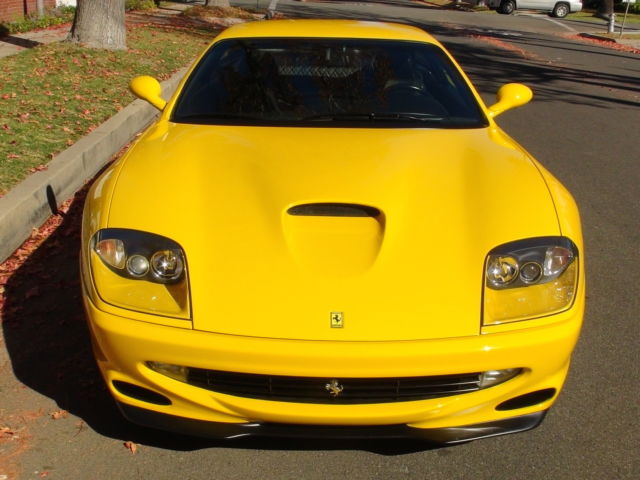
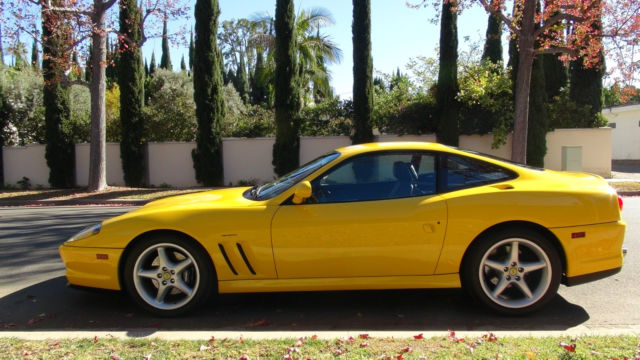
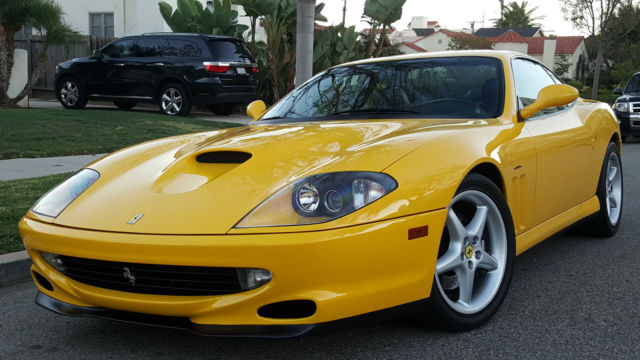
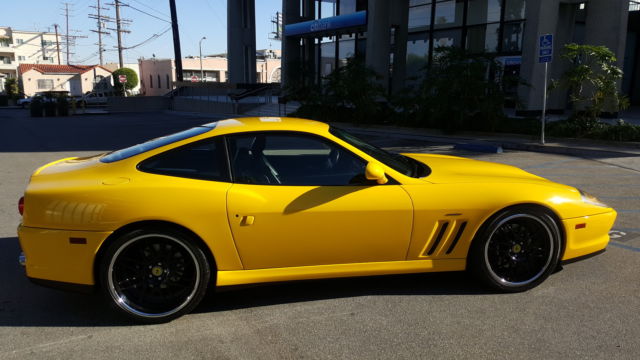
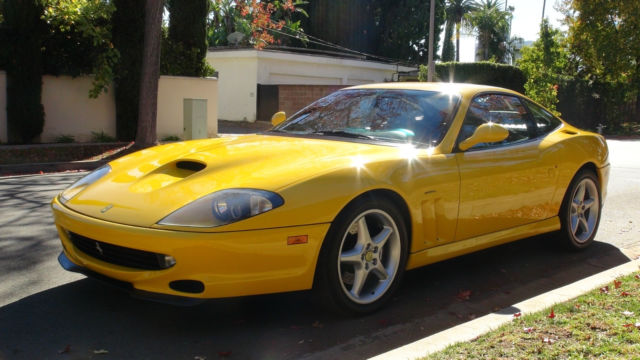
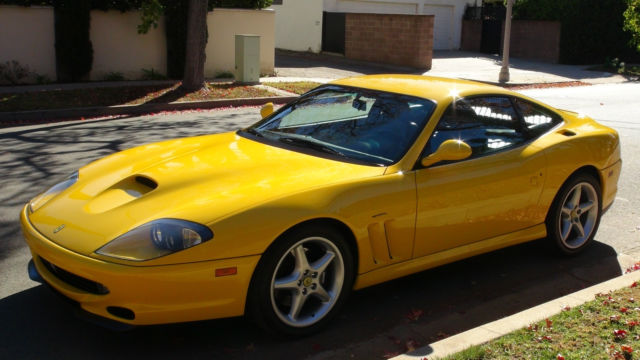
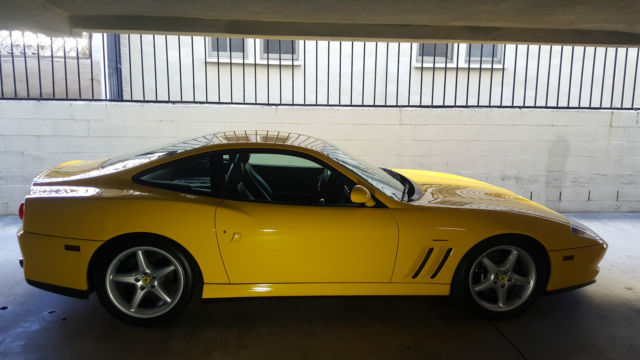
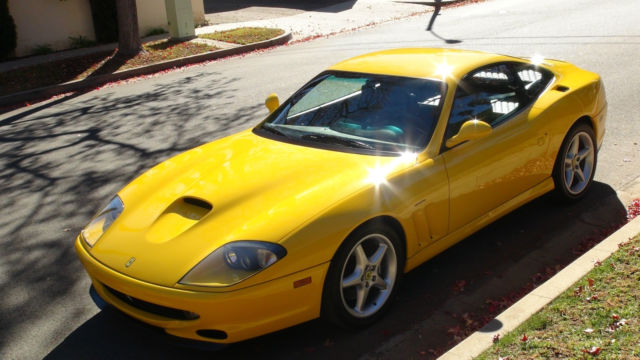
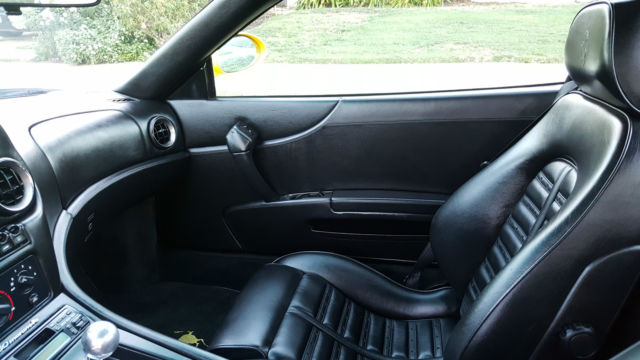
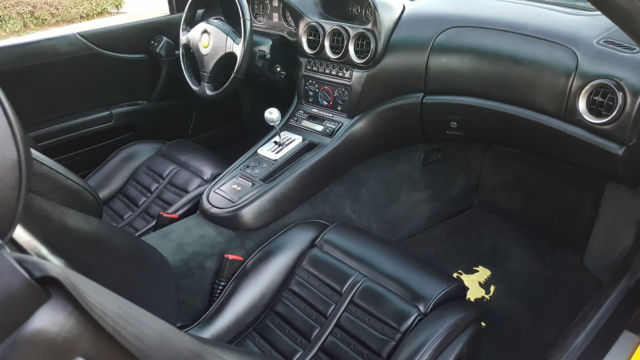
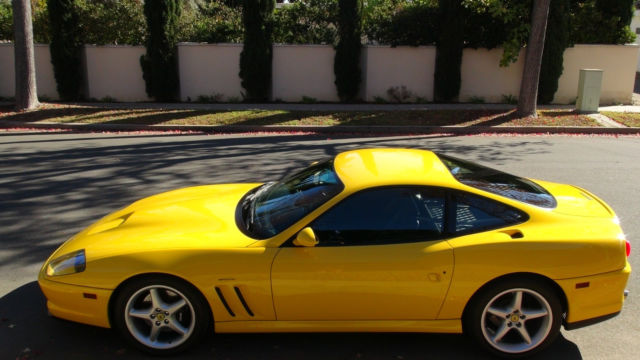
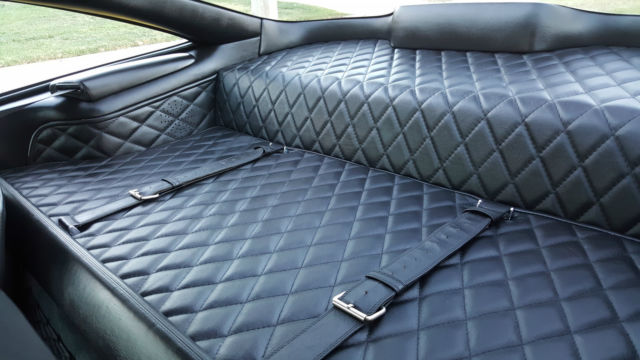
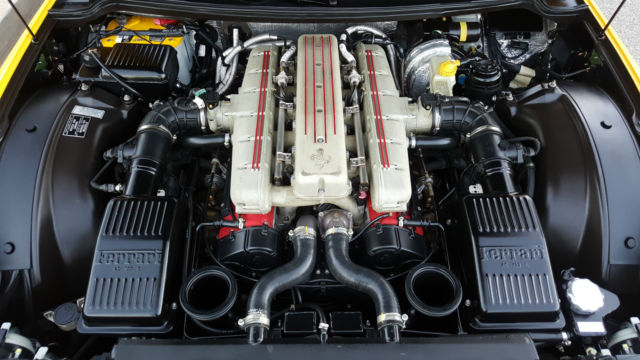
 Ferrari 360 Modena F1, Yellow with Black Daytona seats w/Yellow piping, shields!
Ferrari 360 Modena F1, Yellow with Black Daytona seats w/Yellow piping, shields!
 2015 Ferrari 458 Speciale A in Giallo Modena Yellow / Aperta / Italia 618 Miles
2015 Ferrari 458 Speciale A in Giallo Modena Yellow / Aperta / Italia 618 Miles
 05 Ferrari 430-Scuderia Ferrari Shields-Daytona Style Seat-Yellow Brake Calipers
05 Ferrari 430-Scuderia Ferrari Shields-Daytona Style Seat-Yellow Brake Calipers
 "Adreline Rush" !!!..1992 Ferrari 348 TS "Giallo Fly Yellow" / Black Leather !!!
"Adreline Rush" !!!..1992 Ferrari 348 TS "Giallo Fly Yellow" / Black Leather !!!
 1995 FERRARI 348 SPIDER GIALLO MODENA YELLOW BLACK 20K MILES MANUAL TRANSMISSION
1995 FERRARI 348 SPIDER GIALLO MODENA YELLOW BLACK 20K MILES MANUAL TRANSMISSION